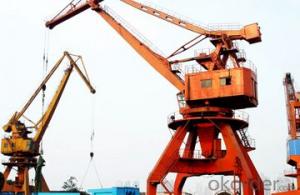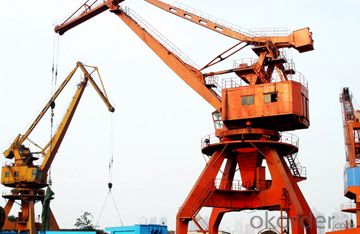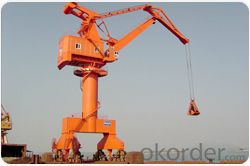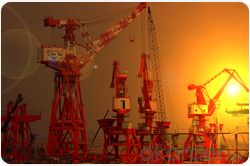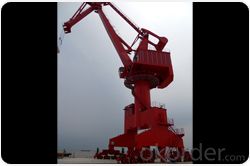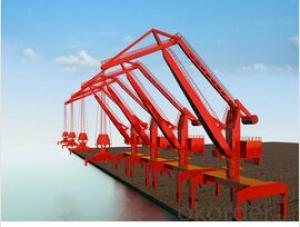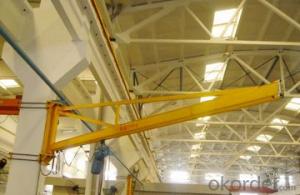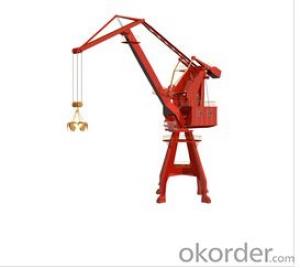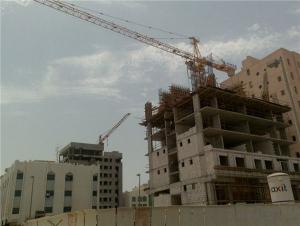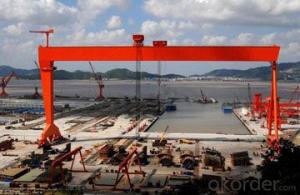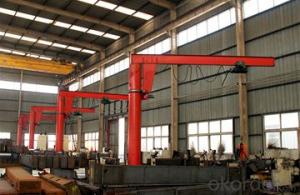Shipyard Portal Jib Crane
- Loading Port:
- Shanghai
- Payment Terms:
- TT OR LC
- Min Order Qty:
- 1 unit
- Supply Capability:
- 20 unit/month
OKorder Service Pledge
OKorder Financial Service
You Might Also Like



Port or harbor portal crane is used for loading and discharging cargos from ships or shipbuilding. It is suitable for various ports and shipyards with hook, hanger, grab, container spreader etc. Portal Jib crane is also called mobile slewing and luffing crane due to its working features.
Features:
1. Power source is three-phase alternating current, rated frequency is 50HZ, rated voltage is 380V.
2. The temperature in the working environment should be in the scope of -20°C~+45°C and the relative humidity is no higher than 95%(with dew).
3. In-service, the wind speed should be no higher than 20 m/s; and out-of service, the wind speed should be (35-42) m/s.
4. The installation of the crane rail should accord with requirement of Jt5022.
Technical Data:
parameters | 30t | 60t | 80t | 100t | 150t | 200t | |
Lifting weight | Main hook(t) | 30 | 60 | 80 | 100 | 150 | 200 |
Auxiliary hook(t) | 8 | 16 | 16 | 16 | 20 | 20 | |
Work radius | Main hook(t) | 18-45 | 18-40 | 16-50 | 16-50 | 16-50 | 20-50 |
Auxiliary hook(t) | 20.8-50 | 19.9-43.8 | 18.5-55 | 18.5-55 | 18.5-55 | 23-53 | |
Max. lifting height | Main hook(t) | 50 | 45 | 63 | 63 | 63 | 65 |
Auxiliary hook(t) | 53.8 | 50 | 68 | 68 | 68 | 68 | |
Lifting speed | Main hook(t) | 8.6 | 6.24 | 4.5 | 4 | 4.5 | 5 |
Auxiliary hook(t) | 15 | 20 | 13.6 | 13.6 | 13.6 | 20 | |
Travelling speed (m/min) | 16.2 | 20 | 16.86 | 16 | 16 | 16 | |
Rotation spped (r/min) | -0.4 | -0.4 | -0.31 | -0.4 | -0.3 | -0.3 | |
rail span(m) | 10 | 10 | 10 | 10 | 10 | 10 | |
- Q: What precautions should be taken when using lifting equipment to ensure safety?
- <p>Safety measures for lifting equipment include regular inspections and maintenance to ensure equipment is in good working order. Operators must be trained and certified for the specific equipment they are using. Safe lifting practices should be followed, such as never exceeding load limits, using the correct lifting points, and securing loads properly. Personal protective equipment (PPE) should be worn, and clear communication among the lifting team is essential. Additionally, a safe working environment should be maintained, free from obstructions and hazards, and emergency procedures should be in place and known by all involved.</p>
- Q: This question asks about the methods to ensure that lifting equipment is correctly positioned and functioning during its operation.
- <p>To ensure that lifting equipment is properly aligned during operation, follow these steps: 1. Conduct a thorough inspection before use, checking for any visible damage or misalignment. 2. Use precision measuring tools to verify the alignment of the equipment's components. 3. Adhere to the manufacturer's guidelines and specifications for alignment. 4. Regularly calibrate the equipment to maintain accuracy. 5. Train operators on proper alignment procedures and safety protocols. 6. Implement a maintenance schedule to address any alignment issues promptly. 7. Use load testing to confirm that the equipment can handle the intended load without misalignment. Proper alignment is crucial for safety and efficiency in lifting operations.</p>
- Q: This question asks for the different types of lifting equipment that can be compatible with a building hoist.
- <p>Building hoists are commonly used in construction projects to lift materials and personnel. Compatible lifting equipment includes various types of hooks, slings, and shackles for securing loads; lifting beams for heavier or bulkier items; and specialized attachments like pallet forks for moving palletized loads. It's crucial to use lifting equipment that is rated for the weight of the load and compatible with the hoist's specifications to ensure safety and efficiency.</p>
- Q: This question asks if single-rope lifts can experience malfunctions or create safety risks.
- <p>Yes, single-rope lifts can malfunction and pose safety hazards. Like any mechanical system, they are subject to wear and tear, component failure, and human error. Factors such as inadequate maintenance, poor weather conditions, and operator negligence can lead to malfunctions. Safety hazards may include rope breakage, sudden stops, or even derailment. However, modern lifts are equipped with multiple safety features such as emergency brakes and redundant systems to minimize these risks and ensure passenger safety. Regular inspections and adherence to safety protocols are crucial to prevent malfunctions and maintain the safety of single-rope lifts.</p>
- Q: What are the key safety rules and regulations that must be followed when operating a building hoist?
- <p>Safety regulations for using a building hoist include ensuring that the hoist is inspected and certified by a qualified person before use. Operators must be trained and certified. The hoist should be used only for its intended purpose, and load limits must never be exceeded. Regular maintenance and checks are required to ensure the hoist remains in good working order. Safety devices such as limit switches and emergency stops must be operational. The hoist area should be kept clear of obstructions, and warning signs should be posted. Personal protective equipment (PPE) must be worn by operators and anyone in the vicinity. Overhead protection should be provided to prevent objects from falling onto the hoist. Compliance with local and national regulations is also crucial.</p>
- Q: What is the safety device for construction elevator?
- A lot of 1, anti-drop safety device 2, upper and lower limit 3, extreme limit 4, buffer spring 5, line door limit switch Single line door limit switch 7, ceiling switch 8, enclosure door lock 9, single door lock The door lock is on and off There are also many electrical safety protections
- Q: This question asks for an explanation of the functioning of hydraulic cylinders in lifting equipment.
- <p>Hydraulic cylinders in lifting equipment operate by converting hydraulic pressure into linear mechanical motion. They consist of a cylinder barrel, a piston, and a piston rod. When pressurized fluid is introduced into the cylinder, it pushes the piston, which in turn moves the piston rod. This movement is what lifts or moves the load. The force exerted by the piston is proportional to the pressure of the fluid and the area of the piston. The cylinder's design allows for controlled and precise lifting, making it ideal for heavy-duty applications where power and control are required.</p>
- Q: What are the necessary maintenance and inspection procedures for hydraulic building hoists to ensure their safe and efficient operation?
- <p>Hydraulic building hoists require regular maintenance and inspection to ensure safety and efficiency. Daily checks should include visual inspections for leaks, proper functioning of controls, and safe operation of the hoist. Monthly inspections should cover the condition of hydraulic hoses, cylinders, and seals. Annual inspections should be conducted by a qualified professional to check the structural integrity, load-bearing components, and overall mechanical condition of the hoist. Regular lubrication of moving parts and replacement of worn components are also crucial. Always adhere to the manufacturer's guidelines and local regulations for maintenance and inspection intervals.</p>
- Q: This question asks for a comparison between electric and electric-hydraulic building hoists, highlighting their distinct features and how they differ from each other.
- <p>Electric building hoists are powered solely by electric motors, which provide direct and precise control over the lifting and lowering of loads. They are quieter, require less maintenance, and are more energy-efficient compared to their hydraulic counterparts. On the other hand, electric-hydraulic building hoists combine the power of an electric motor with the force amplification capabilities of hydraulic systems. These hoists offer greater lifting capacity and can handle heavier loads but are generally more complex, requiring regular maintenance of hydraulic components. They are also louder and may consume more energy. The choice between the two often depends on the specific requirements of the lifting task, such as load capacity, precision, and environmental considerations.</p>
- Q: Is it possible to replace an electric motor with a hydraulic cylinder in an electric-hydraulic lifting system?
- <p>No, a hydraulic cylinder cannot be used in place of a motor in an electric-hydraulic lifting system. A hydraulic cylinder is a component that converts hydraulic pressure into linear motion, while an electric motor converts electrical energy into mechanical energy. In an electric-hydraulic system, the motor drives a hydraulic pump, which generates the pressure needed to actuate the cylinder. The motor is essential for providing the power source, and the cylinder is the actuator that uses this power to perform work. Replacing the motor with a cylinder would result in a system without a power source, rendering it inoperative.</p>
Send your message to us
Shipyard Portal Jib Crane
- Loading Port:
- Shanghai
- Payment Terms:
- TT OR LC
- Min Order Qty:
- 1 unit
- Supply Capability:
- 20 unit/month
OKorder Service Pledge
OKorder Financial Service
Similar products
Hot products
Hot Searches
Related keywords
